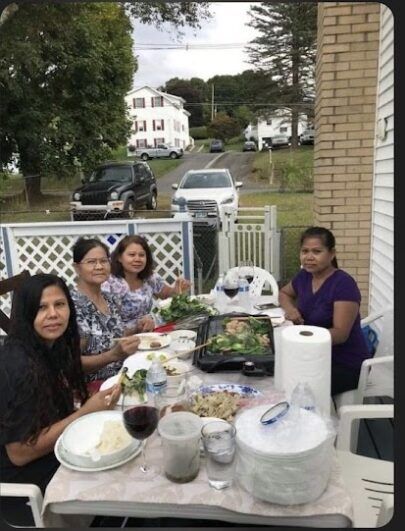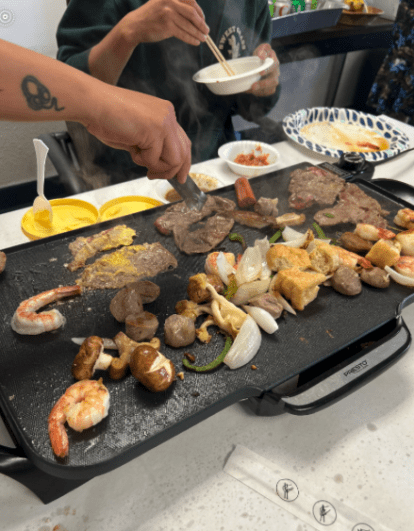By Nary Rath
It’s a frigid day, the air is dry, and snow is falling like pillowy stardust piling high on the streets of my small town in Connecticut. There is something always so peaceful to me about the silence that a snowstorm brings to my life. Because of the citywide mandate to stay off the roads, I love that there are no expectations from me besides to eat, nap, and spend time with my family. My tiny childhood home is quaint and inspires a sense of love and affection. My mom is a first-generation homeowner, and she makes it a point to share this home with her family and friends to build unforgettable memories. My mom is also considered the best cook in my family, so cousins, aunts, and uncles flock to her home to eat her rich, flavorful, and authentic Cambodian food.

On this day, my mom prepares a very special meal; kor leung phnom, or butter pan in English. My home fills up with the scent of savory fatty meats grilling on a burning hot griddle and the smell of the fermented fish paste sauce, tuk prahok, is released into the atmosphere. My mom greets my family members by asking “Nyam bay nau?”— a Khmer saying meaning “have you eaten yet?” My sister Julie and my cousins Monika, Lakhena, and Patrick gather around the table as we assemble the Asian veggies like watercress, Chinese broccoli, and bok choy. They also place raw shrimp, squid and pork belly on the table surrounding the griddle. My cousin starts filling shot glasses with Hennessy, and we exclaim “Cheers!” in unison and ‘clink’ glasses to celebrate our togetherness. I say to Monika, “Today’s definitely going to be a hair wash day.” She laughs and replies, “I know, whenever we eat butter pan it makes all my clothes smell!”
But we know the delicious meal is worth it; the fragrant buttery scent is just a signature part of the whole experience. My mom hands me a special sauce that she makes just for me because I don’t favor the tuk prahok. It’s a simple sauce made from lime juice, minced garlic, salt and pepper. The fatty meats charred to perfection on the griddle dipped in the acidic and tangy flavor of the sauce and eaten with a warm scoop of rice was a bite made from the heavens.
There’s something interesting to me about the concept of Cambodians transforming the electric griddle — which is typically used in the United States to make American breakfast like pancakes and eggs — and taking this appliance as our own by creating a traditional Khmer experience.
I think that speaks volumes about Cambodians’ abilities to adapt to different cultures and to bring a piece of our heritage to America, especially after experiencing forced relocation and displacement. There’s something beautiful about the resilience of Cambodian people — learning to make a community of our own in places like frigid Connecticut, which barely has any resemblance to our home country. Even though we’ve lost so much during the genocide, wartime, and resettlement, we still manage to create joyous moments together and discover new meaning and purpose for ourselves in America.

Now going on three years at SEARAC, I’ve been able to find my identity and place in this country as ‘kon Khmer,’ or child of Cambodia. I no longer feel like a foreigner in America, but rather an integral part of the history and what shapes diversity in this country today. Now living in Southern California, I have the opportunity to live in an area with a high population of Asian Americans and Pacific Islanders, which has helped reinforce how important my story as kon Khmer is to share. But I’ll never forget my roots of living in the white-dominated part of Connecticut, where finding a sense of community with other AAPIs was rare and hard to come by.
This is why today it’s important for me to bring my culture to my friends, introducing them to Cambodian food, dance, and customs. Today, I continue the tradition of eating butter pan with loved ones because it brings so many generations of folks together to sit for hours talking and laughing while always fighting over the last perfectly charred piece of shrimp.
Nary Rath is SEARAC’s California Program Manager and can be reached at nary@searac.org.
For more blogs in our #VisibleandVibrant series for AANHPI Heritage Month, see:
- “I remember Hmong means free” by Kham Moua
- “Family-style meals and a community centered movement” by Jazmin Garrett
- “Dual identity” by Katrina Dizon Mariategue
- “Finding home through community” by Lisa Le
- “Reflections from the pews: Navigating faith, heritage, and cultural loss” by Phun H

